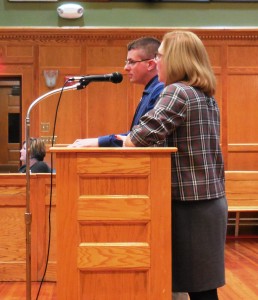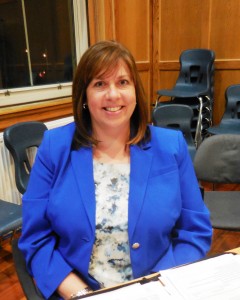WESTFIELD – Westfield Public Schools Superintendent Stefan Czaporowski, gave a state of the district presentation to the School Committee Monday, with the help of Susan Dargie, director of curriculum and instruction, and Denise Ruszala, director of assessment and accountability.
Czaporowski began with an overall picture of the district, which has 5,558 students and 431 teachers. He said Westfield is classified as a gateway city, because 45% of the students are classified in one or more of the high needs categories, which include economically disadvantaged, living in poverty, students with disabilities and English language learners.

Westfield Public Schools Superintendent Stefan Czaporowski and Denise Ruszala, director of assessment and accountability, give a state of the district presentation to the School Committee Monday. (Photo by Amy Porter)
He said the schools are classified by levels according to their progress in reducing the proficiency gap for their students. Each school receives a proficiency target based on where they were and where they need to be to achieve MCAS proficiency for all students. The annual target is halfway up the proficiency gap.
“It’s very complex. Each school tells a different story,” said Ruszala.
Each school is given a classification level from the Department of Elementary and Secondary Education, based on the annual progress and performance index. The schools are given the same classification as their lowest performing sub-group, meaning if one group achieves below the target, then the whole school receives that level.
The district also receives the same level as its lowest performing school. The Westfield Public School District currently has a Level 3 classification, which is considered the lowest performing 20% among schools. However, both Czaporowski and Ruszala said that WPS is at the top of the Level 3 Districts, and they look forward to moving up in the next few years.
The target for proficiency is 75, and the district has a cumulative proficiency index of 64, with the high needs sub-group at 54.
“It becomes a target that is constantly moving,” Ruszala added. She said the administration constantly looks at the data to see who the students are. This past year, for example, there was growth and access among the English language learners. The district has 70 new ELL learners since the beginning of this school year, 40 with little or no English or schooling. Six new ELL students have arrived in the past week.

Susan Dargie, WPS director of curriculum and instruction, was recently recognized at Westfield State as a teacher who made an impact. (Photo by Amy Porter)
Massachusetts has voted to adopt the MCAS Next Generation test, which will be required for all tenth grade students beginning with the Class of 2021, who are this year’s eighth graders.
School Committee member Robert Duval asked what kind of special programs existed for students who do not achieve proficiency in the assessments.
Czaporowski said the district offers interventions for reading, extra help sessions after school, and Saturday classes.
“We are able to identify students at risk very early,” Czaporowski said. He said the district has received a $40,000 grant to offer a program beginning in January to high risk students in high school called Pathway. This program will offer an afternoon school (3-6 p.m.) for students to work and/or perform community service during the day, as an alternative to suspension. These students will be supervised by a teacher, counselor and para-professional.
The district is also re-engaging students who have dropped out, with eight students coming back and doing the work needed to graduate.
“Students who drop out of school are less likely to be successful,” Czaporowski said.
Dargie spoke about the curriculum renewal underway in the district. She said the focus the past few years has been on math and English language arts, for both curriculum updates and professional development. The school is now shifting its curriculum renewal to three other areas: STEM (science, technology and engineering), comprehensive health and social studies.
Dargie said new materials and textbooks for science up through fifth grade were included in this year’s budgets. The middle school has just decided to move to studying an inclusive STEM curriculum which comprises all of the strands, and will have students then move to individual courses on each subject in high school.

Grace Trempe, a fourth grader at Paper Mill Elementary, shows her artwork along with her classmates to the School Committee at the start of the meeting on Monday. (Photo by Amy Porter)
The district is also currently pursuing a grant to purchase the Botvin health curriculum recommended by Dr. Ruth Potee, a state leader addressing the opioid crisis. The curriculum, for grades 3 through 12, costs $100,000 over three years, and $55,000 the first year.
School Committee member Jeffrey Gosselin made a motion at the end of the presentation to review the curriculum in the Curriculum and Instruction Subcommittee, on which he and Duval serve. The motion passed the committee.
New curriculum for social studies is currently being addressed by lead social studies teachers and department heads.
“We are aligned with the shift in social studies to a more inquiry-based approach,” Dargie said. She said it will include civics, geography and history, bringing all of the strands together. She said there currently is no state-wide social studies assessment, but it is in the works.
“What’s the relationship between testing and what’s taught in the classroom,” asked Duval.
Dargie responded that the administration, department heads and lead teachers focus on nine different indicators among student performance. She said teachers meet frequently on curriculum and data. She said at these meetings, if they see that 80% of the students in any given class fail to achieve mastery of a standard, the whole class is retaught. They also encourage sharing successful practices among teachers.
Dargie also said if 5% of a class doesn’t achieve mastery, they might offer an intervention for that group.
“Not all students in a grade have the same ability,” Duval said.
Dargie said the teachers are looking at the skills the students have mastered in the classroom.
“With MCAS, we really look at student growth rather than measuring student achievement,” she added.
The state of the district presentation is available on the website at www.schoolsofwestfield.org.
Czaporowski also spoke about strategic initiatives in the works, which he will address at the next meeting. He also recognized Susan Dargie for having receiving an award at a recent Westfield State University annual meeting for teachers and education majors.
WSU education students are able to nominate a teacher who has had a big impact in their lives and decisions to pursue teaching. Both Susan Dargie and Deborah Auclair of Westfield Public Schools were recognized by students at the meeting and received a plaque.
Dargie said the student who nominated her was in her class in 1997, one of her first years as a teacher.
“I was so honored,” Dargie said.

